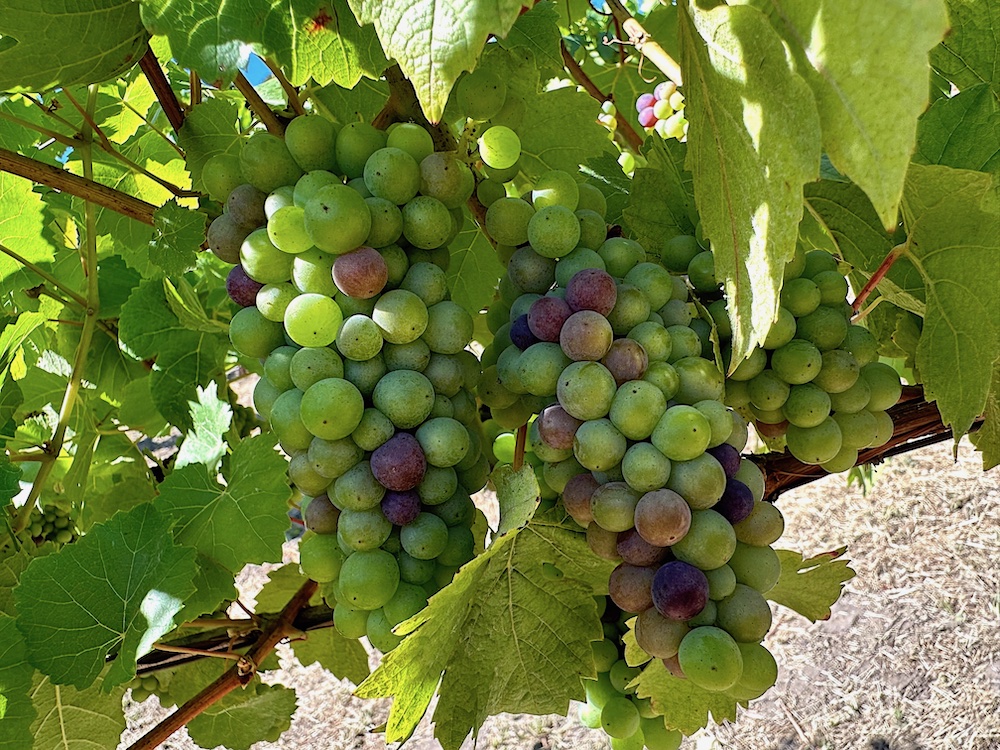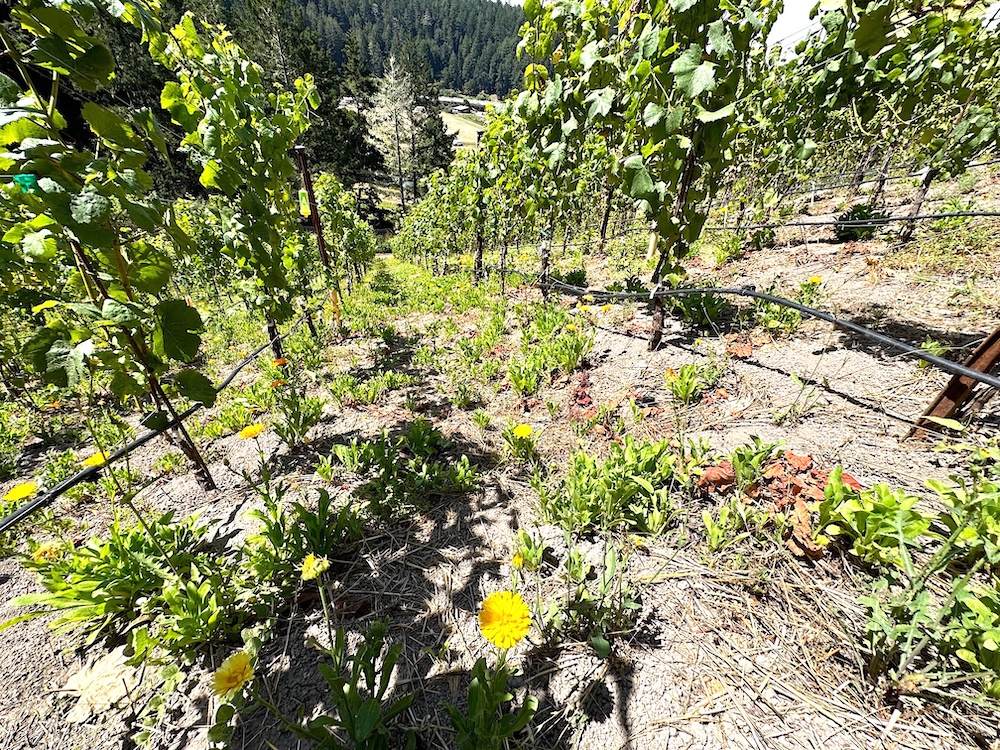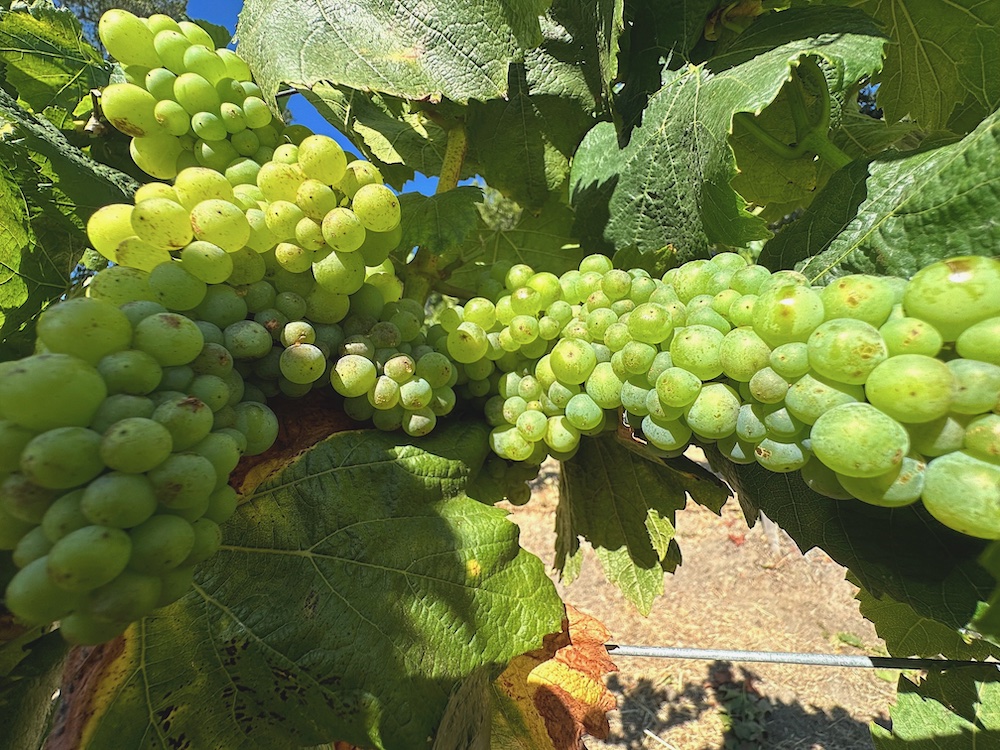
August 15, 2023 – It’s that magical moment when the grapes begin to soften and turn color, marching their way towards ripeness and eventual harvest.
Veraison, that French word for the transformation of grapes from hard green marbles to something approaching juicy and appealing, is noticeably late this year, especially in cooler coastal areas.
With the arrival of veraison begins the countdown to harvest, generally about 6 to 7 weeks out, depending on the weather. Last year looked to be a beautiful harvest, right up until the brutal two-week heat wave that blast-furnaced us just prior to Labor Day weekend and wouldn’t let up. Let’s skip that nightmare this time.
Longtime growers tell me that even when we have an eternal wet spring and late bloom, like we did this year, the vines always catch up. They have a vested interest in propagating seeds.
Right now, the vines are maximizing photosynthesis to sugar up and color the berries, which serve as irresistible bait to wildlife like birds, turkeys and deer (also racoons, bears and foxes). Their job is to become propagation ambassadors by spreading seeds.
The persistent heat we’ve been experiencing should hasten grape development, with harvest likely beginning for some on the Central Coast by the second week of September. But it’s all a matter of location, location, location.
Veraison was spotted in a few skimpy bunches of Pinot Noir at Wrights Station on the Summit area earlier last week, but everything else looked rock hard green. Winemaker Dan Lokteff asked if anyone would like to volunteer to help harvest in November at the rate things are going. Burrell School reports some spotty coloration in the Pinot Noir as well, most likely on stressed vines or bunches with poor set. By this time in the Santa Cruz Mountains, veraison is usually pretty much complete in Pinot Noir, regardless of clone or location, and Chardonnay has begun to fatten and take on a tad of vague yellowness.
At Soquel Vineyards, where Peter Bargetto and company are bottling the 2022s in the hills above Soquel, he says it’s a healthy crop and the quality is very high. He expects to bring in the first of the fruit for the Trinity blend on Sept 10. He told us, “My intuition tells me all the Pinot Noir vineyards will ripen at the same time, around the end of September to first week of October.”

John Benedetti of Sante Arcangeli is also predicting that everything will arrive at once, with Hand in Hand Pinot Noir arriving first, and most everything from Lester, Split Rail, Valley Vista and Toulouse (Anderson Valley) arriving just afterwards, likley the first week of October, a situation he anticipates will be “bonkers.” He’s expects that Bates and Saveria fruit will arrive perhaps a week later. Time for a last-minute camping trip?
In the Chalone area, where it’s always toasty and harvest typically begins in August, Michael Michaud told us he’d seen the first of veraison on August 5. Late, for sure but, he’s stoked.
“This year’s crop in the Chalone AVA is on its way to be one of the best vintages in 40 years. The very wet winter of just over 19 inches of rain restored a lot of lost soil moisture and the creeks flowed until almost July. Luckily, it has also been a much cooler summer than last year, so far, with only a few days over 100, and only a handful around 95-97. If we don’t get the usual hot spell just before harvest, it will be a magnificent and decent sized harvest,” says Michaud.
His vineyard, which looks up at the Pinnacles, where condors cast bus-sized shadows on the hillsides, also enjoys a stunning view of the Santa Lucias. It’s a sandy, arid desert, dessicating to most life forms that thrive just across the highway in Salinas. Not a place to grow salad, but tomatoes can prosper. Luckily his reservoir remained full until July 1. He grows mostly Pinot Noir, including three selections of old Chalone clones, plus 113, 114, 115, 667 and 777. Of the Chalone clones, he says that one has very small clusters and small, relatively lightly colored berries with nice aromatics, and a second has larger berries, darker color, rose-like flavors and aromas with nice tannins. “I expect one or the other or both may have come from Wente. Will Silvear who planted Chalone used to sell grapes to Wente, as told to me by Caroline Wente years and years ago.”
The third clone he describes as intermediate in size, with good color, aroma and flavors, and moderate tannins. He thinks it may have come from David Bruce around 1970/72.
If you’re looking for fruit, give him a shout. He’s got about 15-17 tons available of excellent looking Pinot Noir available. It should be ready around 9/10/23.
Greg Freeman, winemaker at Chalone Vineyard, says things are definitely behind, and he had seen maybe 40% veraison in the Pinot Noir in the Upper vineyard as of the second week of August.
Joe Alarid of Tondre Grapefield says he has one section of Pinot Noir, all Pommard and 115, at 70% veraison. This is about 3 to 4 weeks behind. He’s hopeful that harvest can start without a heat wave and then roll through smoothly as ripeness happens to the satisfaction of his winemaking clients.
“David Baird of Folktale always is the first to pick,” says Alarid. “He comes out and tastes multiple times throughout the vineyard. He knows what he’s after, and I love that he always runs chemistry and shares it, letting me know where things are at.” This helps immensely in scheduling the other winemakers who typically like to pick a bit later, like Bernardus, Sarah’s Vineyard, Sabrine Rodems of Wrath and in the past, Dave Coventry.
Says Alarid, “Coventry was always the last to pick. But now Jeffrey Blair is buying my fruit, and that honor goes to him. Some really like their Pinot Noir really, really ripe, with all those dark fruit flavors.”

Ken Swegles of Rhizos Viticulture in the Santa Cruz Mountains says he thinks the first fruit harvested will be from vineyards in Los Altos, and also from Rider Ridge, about 4 to 6 weeks out, depending on the heat. Ascona Vineyard, on Skyline, is very far behind, although he’s seen a bit of veraison in clone 115 Pinot Noir. Swegles anticipates picking for Neely Pinot Noir rosé in about 4 to 5 weeks, which is definitely a bit later than last year. The clusters of both Pinot Noir and Chardonnay at Neely in Portola Valley are quite well-formed and robust. Swegles and his partner in Madson Wines, Cole Thomas, anticipate getting some lovely Pinot Gris this year from Pescadero Creek Vineyard, which they recently budded over. The crop looks pretty good.
On the other hand, he says, “We have pretty bad shatter in our Alto Adige clone of Sauv Blanc and Swan Clone Pinot Noir.”
“A lot of our other coastal clients had intense shatter. However, Pommard, Mount Eden, Martini and 115 Pinot Noir are looking excellent,” Swegles observed.
In the south end of the Santa Lucia Highlands, Paul Clifton of Hahn tells us, “The harvest looks very late this year. Some mildew in Chardonnay. Veraison is really just getting started, a month late. Looks like a lot of PN coming in October and Chardonnay, pushing into November, unless we get some major heat spike like last year. Pushing that late comes with the threat of rain, which they just saw last week down south.”
With the recent acquisition of Hahn by Gallo, the grapes may turn sweet, but the whole experience for the Hahn team is bittersweet.
Says Clifton, “This will be the first harvest in 27 years where I won’t be touching a grape. All the fruit will be going elsewhere. I guess it will be a good one to watch from the sidelines.”
About the author
Laura Ness is a longtime wine journalist, columnist and judge who contributes regularly to Edible Monterey Bay, Spirited, WineOh.Tv, Los Gatos Magazine and Wine Industry Network, and a variety of consumer publications. Her passion is telling stories about the intriguing characters who inhabit the fascinating world of wine and food.
- Laura Nesshttps://www.ediblemontereybay.com/author/lness/
- Laura Nesshttps://www.ediblemontereybay.com/author/lness/
- Laura Nesshttps://www.ediblemontereybay.com/author/lness/
- Laura Nesshttps://www.ediblemontereybay.com/author/lness/


